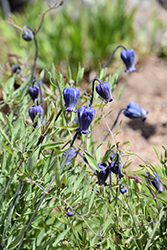It's all about ...
plants

Scott's Sugarbowls Clematis
Clematis hirsutissima var. scottii
Plant Height: 8 inches
Flower Height: 12 inches
Spread: 18 inches
Sunlight:
![]()
![]()
Hardiness Zone: 4a
Other Names: Sugar Bowl Clematis, Scott's Clematis
Brand: Plant Select
Description:
A unique, non-vining selection featuring tall stems with nodding, violet-blue bell shaped flowers in late spring to early summer, over attractive blue-green foliage; a beautiful addition to garden landscapes and borders; easy to grow and low maintenance
Ornamental Features
Scott's Sugarbowls Clematis features dainty nodding blue bell-shaped flowers with violet overtones rising above the foliage from late spring to early summer. Its tomentose narrow leaves remain bluish-green in colour throughout the season.
Landscape Attributes
Scott's Sugarbowls Clematis is an herbaceous perennial with an upright spreading habit of growth. It brings an extremely fine and delicate texture to the garden composition and should be used to full effect.
This is a relatively low maintenance plant, and should be cut back in late fall in preparation for winter. It is a good choice for attracting hummingbirds to your yard, but is not particularly attractive to deer who tend to leave it alone in favor of tastier treats. It has no significant negative characteristics.
Scott's Sugarbowls Clematis is recommended for the following landscape applications;
- Mass Planting
- Rock/Alpine Gardens
- Border Edging
- General Garden Use
- Groundcover
- Naturalizing And Woodland Gardens
Planting & Growing
Scott's Sugarbowls Clematis will grow to be about 8 inches tall at maturity extending to 12 inches tall with the flowers, with a spread of 18 inches. It grows at a slow rate, and under ideal conditions can be expected to live for approximately 10 years. As an herbaceous perennial, this plant will usually die back to the crown each winter, and will regrow from the base each spring. Be careful not to disturb the crown in late winter when it may not be readily seen!
This plant does best in full sun to partial shade. You may want to keep it away from hot, dry locations that receive direct afternoon sun or which get reflected sunlight, such as against the south side of a white wall. It is very adaptable to both dry and moist growing conditions, but will not tolerate any standing water. It is considered to be drought-tolerant, and thus makes an ideal choice for a low-water garden or xeriscape application. To help this plant achive its best flowering performance, periodically apply a flower-boosting fertilizer from early spring through into the active growing season. It is not particular as to soil type or pH. It is somewhat tolerant of urban pollution. This species is native to parts of North America..
This plant is not reliably hardy in our region, and certain restrictions may apply; contact the store for more information.
